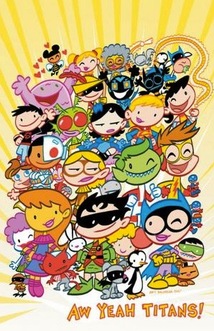 Originally posted at Pencil Panel Page. My daughter started first grade last month and we are reading constantly – anything with words – street signs, food labels, chapter books, and of course, comics. She prefers comic books based on her favorite TV shows (SpongeBob SquarePants, Disney Fairies) along with a few that I enjoy myself, like Art Baltazar’s Tiny Titans… aw yeah, Titans! I have found, though, that reading these stories aloud to her can be an unexpectedly awkward experience, one that may be useful for our conversations here at PPP. It’s hardly as straightforward and immersive as reading a novel and lacks the familiar rhythms of story hour at the public library, in which one recites the words in a picture book before pausing to display the accompanying images. Instead you are compelled to provide your own attribution for the dialogue in a comic, taking care to describe visual components and abstract inferences along with any necessary exposition. You have to note the placement of narrative boxes, sounds, and characters before determining the order in which to convey the events taking place. And if you’re reading to someone fairly new to comics like my six year old, whose eyes roam wildly around the colorful pages, you may end up having to point out key elements in each panel. If you approach the comic as if it is Goodnight Moon, you will be left stumbling. The demands placed on both the reader and the listener (or viewer) are substantial. But I wonder if the experience of reading comics aloud does more than simply affirm the participatory nature of the medium. Once my husband introduced our daughter to his old, dog-eared collection of Calvin and Hobbes, for instance, the strip quickly became her favorite and most requested comic. I was puzzled at first (I thought she wouldn’t get the deadpan humor) but after watching them spend ten minutes laughing over a single four-panel strip, it wasn’t hard to figure out why she loves it so much. Dad does the first read through and selectively translates what he sees in a way that she can understand, and then they end up going over and over the comic several times, highlighting new details in each panel that buttress the strip’s punch line. The hilarious facial expressions alone invite multiple, extended readings in these strips and it isn’t long before my daughter has invented new dialogue to capture what Hobbes is really thinking here and or visualizing what Calvin could possibly do next there. What I hear in these bedtime story performances are hardly recitations of comics that Bill Watterson wrote and illustrated, but something closer to revisions and rewritings of his strips – and that is what interests me the most. The act of reading the comic aloud, rather than generating an immersive experience, seems to necessitate a vigorously interpretive one. In previous posts, Barbara has touched on the question of immersive reading, while Roy offers a different kind of rereading of a Calvin and Hobbes strip. I wonder what we might make of their queries if we also think of comics as the kind of text that can extend beyond the silence of the page into collective reading modes. Although my daughter has seen every page of that Calvin and Hobbes collection over a dozen times, could it be possible that she has never encountered the same comic strip twice? And perhaps never will?
Comments are closed.
|
AboutAn archive of my online writing on comics, literature, and culture. (Illustration above by Seth!) Categories
All
Archives
July 2020
|


 RSS Feed
RSS Feed